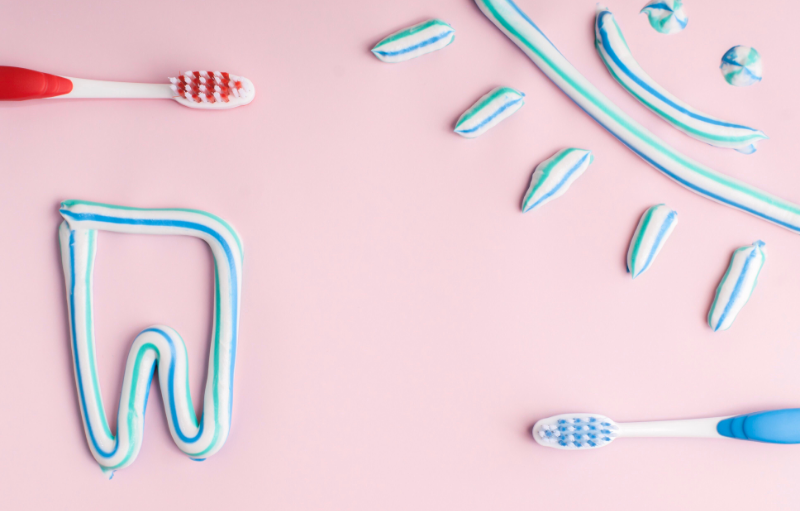
Tomorrow, the 20th of March, is World Oral Health Day. As such, this month we dedicate our attention to this topic. Promoting adequate oral hygiene is a determining factor, which contributes not only to the prevention of numerous diseases that affect the oral cavity but also to general well-being.
Although we are familiar with the concept, the rush with which we face everyday life does not always allow us to pay attention to details and/or dedicate the necessary time to the care of our teeth and gums. Bearing this in mind, we have selected some steps for preventive daily care and also some products that, in this context, will allow you to have a healthier mouth!
Good oral hygiene necessarily involves two steps: flossing and brushing. However, there are other behaviors that jointly contribute to reducing the risk of developing some complications (cavities, tooth sensitivity, canker sores, tartar, halitosis, gingivitis, and periodontitis), such as: opting for a balanced diet and using products with fluoride, namely in toothpaste and mouthwashes.
Starting at the beginning, how can we use dental floss correctly?
The answer is simple and comprises only 3 steps. First, remove approximately 40 cm of dental floss. Then, with the middle finger of one hand, wrap most of the thread and place the smaller portion on the middle finger of the other hand, leaving between 2 to 3 cm of thread between the two fingers. Then, insert the thread between two teeth and curve it around each of them, making smooth horizontal movements and, finally, as you use the thread, unwind it on one of your fingers, winding it on the other. If by chance, there are larger interdental spaces, you can use thicker dental floss (the well-known superfloss) or, for example, opt for the use of interdental brushes.
The second question that arises is, then: how can we brush our teeth correctly?
Well, in this sense, the first step is to choose a suitable toothbrush and toothpaste. Therefore, despite the numerous options available on the market, a good toothbrush should:
Choosing a toothpaste that suits our needs also includes a series of requirements. First, it is important to be aware that drinks and acidic or sweet foods can cause tooth decay or abrasion. As such, to reverse this process, it is necessary to reinforce the enamel, so it is recommended to use pastes or gels that contain between 1000 and 1500 ppm (parts per million) of fluoride. This mineral is therefore very important for strengthening teeth and preventing cavities. However, its excessive use can cause stains – fluorosis – or even contribute to the weakness or porosity of the enamel.
The use of more specific toothpaste allows, thanks to its ingredients, to alleviate some of the most common problems. Tooth sensitivity is caused by enamel erosion, which leads to exposure of dentin, giving access to the center of the tooth – the pulp – where the nerve is. Thus, in this case, it may be important to choose a toothpaste with potassium nitrate or stannous fluoride, as these allow desensitization of the nerves (acting on the synapses) and also the blocking of the holes in the microscopic tubules/channels (present in the dentin), respectively. These actions allow you to stop feeling the discomfort and pain caused by temperature changes and can be found in products such as Gum Sensivital Toothpaste and Bexident Sensitive Teeth Toothpaste.
With regard to problems such as gingivitis, in addition to fluoride, triclosan, for example, also plays a prominent role, due to its antiseptic action - being a bacteriostatic agent - which contributes to reducing inflammation and gum bleeding. However, in addition to this, there are other antiseptic components (such as chlorhexidine) and soothing/healing agents (such as allantoin and dexpanthenol) that contribute to the repair of the epithelium and also to increase its resistance (Bexident Gums Intensive Care Gel Toothpaste). In this way, the use of toothpaste that promotes gum protection is a crucial step to prevent the accumulation of bacterial plaque and the consequent formation of tartar.
Usually, whitening products or those that prevent halitosis are also quite sought after. In the first case, toothpaste based on activated charcoal or sodium bicarbonate, for example, can be used. With regard to bad breath, it is common to find cetylpyridinium chloride and chlorhexidine in toothpaste, which are quite effective in removing microorganisms and volatile sulfur compounds (VSCs).
So, with the right tools, brushing becomes easier! This is a procedure that must be carried out for two minutes, at least twice a day, using a small portion of toothpaste/gel (the size of a pea, which is equivalent to 1.5 ml).
To do this properly, follow a step-by-step guide:
After brushing, using a mouthwash is also an asset to keep your mouth healthy and your breath fresh. There are several elixirs, taking into account the different purposes that motivate their inclusion in your oral hygiene routine. Some allow use in its pure form. Others, in turn, require a prior dilution.
Finally, it is important to remember that the practice of these important daily steps does not exempt you from consulting your dentist, at least twice a year. Taking care of our oral health is a daily responsibility that allows us to protect the health of our oral cavity and prevent the onset of many other diseases and, as such, we must not neglect it!
We are always close to helping you take care of your smile, in a sustainable way, and guarantee your confidence and self-esteem.
See you soon!
Dr. Andreia Moreira